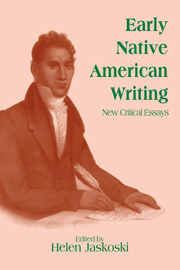Book contents
- Frontmatter
- Contents
- Foreword
- Preface
- List of Contributors
- 1 “Honoratissimi benefactores” Native American students and two seventeenth-century texts in the university tradition
- 2 “Pray Sir, consider a little”: Rituals of subordination and strategies of resistance in the letters of Hezekiah Calvin and David Fowler to Eleazar Wheelock
- 3 “(I speak like a fool but I am constrained)”: Samson Occom's Short Narrative and economies of the racial self
- 4 “Where, then, shall we place the hero of the wilderness?”: William Apess's Eulogy on King Philip and doctrines of racial destiny
- 5 “They ought to enjoy the home of their fathers”: The treaty of 1838, Seneca intellectuals, and literary genesis
- 6 “I am Joaquin!”: Space and freedom in Yellow Bird's The Life and Adventures of Joaquin Murieta, the Celebrated California Bandit
- 7 “This voluminous unwritten book of ours”: Early Native American writers and the oral tradition
- 8 “A terrible sickness among them”: Smallpox and stories of the frontier
- 9 “A desirable citizen, a practical business man”: G. W. Grayson – Creek mixed blood, nationalist, and autobiographer
- 10 “An Indian … An American”: Ethnicity, assimilation, and balance in Charles Eastman's From the Deep Woods to Civilization
- 11 “Overcoming all obstacles”: The assimilation debate in Native American women's journalism of the Dawes era
- 12 “My people … my kind”: Mourning Dove's Cogewea, The Half-Blood as a narrative of mixed descent
- 13 “Because I understand the storytelling art”: The evolution of D'Arcy McNickle's The Surrounded
5 - “They ought to enjoy the home of their fathers”: The treaty of 1838, Seneca intellectuals, and literary genesis
Published online by Cambridge University Press: 20 February 2010
- Frontmatter
- Contents
- Foreword
- Preface
- List of Contributors
- 1 “Honoratissimi benefactores” Native American students and two seventeenth-century texts in the university tradition
- 2 “Pray Sir, consider a little”: Rituals of subordination and strategies of resistance in the letters of Hezekiah Calvin and David Fowler to Eleazar Wheelock
- 3 “(I speak like a fool but I am constrained)”: Samson Occom's Short Narrative and economies of the racial self
- 4 “Where, then, shall we place the hero of the wilderness?”: William Apess's Eulogy on King Philip and doctrines of racial destiny
- 5 “They ought to enjoy the home of their fathers”: The treaty of 1838, Seneca intellectuals, and literary genesis
- 6 “I am Joaquin!”: Space and freedom in Yellow Bird's The Life and Adventures of Joaquin Murieta, the Celebrated California Bandit
- 7 “This voluminous unwritten book of ours”: Early Native American writers and the oral tradition
- 8 “A terrible sickness among them”: Smallpox and stories of the frontier
- 9 “A desirable citizen, a practical business man”: G. W. Grayson – Creek mixed blood, nationalist, and autobiographer
- 10 “An Indian … An American”: Ethnicity, assimilation, and balance in Charles Eastman's From the Deep Woods to Civilization
- 11 “Overcoming all obstacles”: The assimilation debate in Native American women's journalism of the Dawes era
- 12 “My people … my kind”: Mourning Dove's Cogewea, The Half-Blood as a narrative of mixed descent
- 13 “Because I understand the storytelling art”: The evolution of D'Arcy McNickle's The Surrounded
Summary
When the Revolutionary War ended, both New York and Massachusetts claimed the Iroquois lands in New York. In 1786 New York was given jurisdiction over the land, but Massachusetts was granted the preemptive right to purchase it should the Iroquois decide to sell. This preemptive right was sold three times in the next few years, during which time its holders bought tracts of varying size from the Senecas, who under the Treaty of Big Tree (1797) were established on several small reservations in western New York (Abler and Tooker 508-9). Like the other Iroquois, the Senecas became demoralized; social structures broke down, and reservation life sapped the vitality from traditional rituals (Wallace, “Origins” 444-5). Also, like the other tribes, the Senecas were besieged by appeals from Christian missionaries to allow the establishment of mission stations on Seneca land, where there had been little mission work before the war. Although Quakers established a mission among the Allegany Senecas in 1798, other mission groups were not successful until the second and third decades of the nineteenth century. With the missions came schools as part of the machinery for “civilizing” the Senecas. Although there was a school on the Buffalo Reservation as early as 1811 and on the Cornplanter Grant by 1814, schools, like missions, did not gain a solid foothold in Seneca land until the 1820s (Abler and Tooker 509-10).
By that time, the Senecas were split into factions known as the “Christian party“ and the “Pagan party.”
- Type
- Chapter
- Information
- Early Native American WritingNew Critical Essays, pp. 83 - 103Publisher: Cambridge University PressPrint publication year: 1996
- 9
- Cited by



